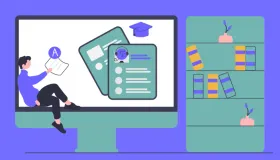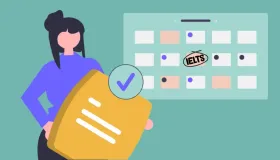Understanding the IELTS Exam Pattern
Planning to take the IELTS Academic test? Here’s how it’s structured:
The IELTS Academic test is meant for those aiming for higher education or work in an English-speaking environment. It checks your ability to handle complex academic language and prepares you for academic or professional challenges.
The IELTS Exam comprises four sections, and the test is conducted using the following flow if you’re giving the test at the centre:
Also note: The speaking section can be assessed before or after other sections of the test.
IELTS Exam Pattern & Syllabus for Academic Writing
In the IELTS Writing section, you'll notice differences depending on whether you're taking the Academic or General Training test.
You have two tasks to complete within a total of 60 minutes. Here's a breakdown:
In both cases, ensure your writing matches what they're asking for. The people checking your test look at how well you do the task, how clear and organised your writing is, the words you use, and how well you use grammar.
IELTS Exam Pattern & Syllabus for Academic Reading
The IELTS Reading section is 60 minutes long and consists of 40 questions distributed among 3 sections. The Reading passages are medium-length and sourced from journals, books, magazines, and newspapers, and they might include graphs, diagrams, or illustrations.
These passages use various writing styles, such as descriptive, factual, discursive, and analytical. Your task is to understand the writers' purpose, attitude, and opinions behind these texts.
The IELTS pattern for the reading test includes 40 questions of different types, each requiring different reading skills. These skills are:
When it comes to question types in the IELTS Reading section, you'll encounter various types:
- Multiple choice
- Identifying information
- Identifying the writer's views/claims
- Matching information
- Matching headings
- Matching features
- Matching sentence endings
- Sentence completion
- Summary, note, table, flow-chart completion
- Diagram label completion
- Short-answer questions
IELTS Exam Pattern & Syllabus for Academic Listening
You will have four tasks in the IELTS Listening section, each with a unique recording.
Within each task, there will be 10 questions, adding up to 40 questions. You'll have 30 minutes to complete this section, and an additional 10 minutes will be given for transferring your answers to the answer sheet. For each correct answer, 1 mark will be awarded.
Let's break down the recording details:
The IELTS Listening section features various question types, including:
- Multiple choice
- Matching
- Labelling plans, maps, and diagrams
- Completing forms, notes, tables, flowcharts, and summaries
- Sentence completion
- Short-answer questions
IELTS Exam Pattern & Syllabus for Academic Speaking
The IELTS Speaking section is very simple and divided into three parts. The speaking test does not need to be conducted on the same day as the test.
When it comes to IELTS Speaking questions, the syllabus and pattern remain the same for both Academic and General Training:
These tasks aim to assess your ability to express your thoughts on daily and given topics and your capacity to provide reasons for your opinions.
IELTS Exam Syllabus & Pattern for General Training Test
The IELTS General Training test is appropriate for you if you wish to migrate to an English-speaking country (Australia, Canada, New Zealand, UK).
The test assesses everyday English language skills you need in social situations and the workplace.
IELTS Exam Syllabus & Pattern for General Training Reading
IELTS General Training Reading conducted for 60 minutes (including the transfer time) includes three sections with excerpts from newspapers, books, magazines, guidelines, advertisements, handbooks, and notices.
Here is the breakdown of the 3 tasks:
IELTS Exam Syllabus & Pattern for General Training Writing
You have two tasks to complete within a total of 60 minutes. Here's a breakdown:
IELTS Exam Syllabus & Pattern for Life Skills Test
The IELTS test format for Life skills includes three different tests:
Each of these tests corresponds to a specific level of language proficiency, following the Common European Framework of Reference for Languages (CEFR) guidelines, which are widely recognised for assessing language skills.
The Life Skills tests consist of two main parts. In the first part, you will asked questions on familiar topics. The second part combines both Listening and speaking tasks.
For those taking the IELTS Life Skills B1 level test, there is an additional task where you'll plan an activity with the other test taker.
You can take notes during the test to prepare your answers, but it's important to note that the examiner will evaluate your speaking and Listening skills, not your notes.
You might wonder why you take the test with another person. IELTS Life Skills evaluates how well you can communicate in everyday English with others.
The most effective way to measure these skills is by pairing you with another candidate of a similar language proficiency level so you can demonstrate your ability to use English to communicate and engage in discussions with others.












